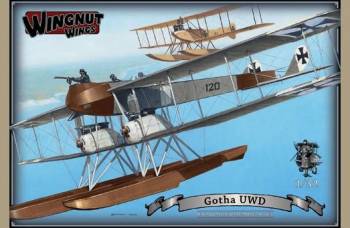1/32 Gotha UWD
|
|
 |
But only from... WINGNUT WINGS
All items from... WINGNUT WINGS
- Released on 12 June 2019
- 63cm x 44cm
- High quality Cartograf decals
- 274 high quality injection moulded plastic parts
- 4 photo-etched metal detail parts
- 160hp Daimler-Mercedes D.III engines
- 10kg Carbonit bombs & LMG 14 Parabellum machine gun armament
- Fine in scale rib tape detail
- Full rigging diagrams.
The unique Gotha UWD seaplane was developed from the Gotha G.1 land plane and although only one was ever built, the highly distinctive twin engined Gotha UWD is nevertheless important because it helped set Gothaer Waggonfabrik on the path to building the more conventional seaplanes and bombers that they became famous for. The aircraft that would serve as the prototype Gotha G.1 was designed by Oskar Ursinus (the founder and editor of Flugsport magazine) to the German Army"s Type III aircraft specifications of a 200hp, 3 seater able to fly at over 120kph and carry 450kg for up to 6 hours. Ursinus proposed the idea of building his Kampfflugzeug (battle plane) to FEA 3 commander Major Friedel in August 1914. The distinctive high fuselage allowed the two 100hp Daimler-Mercedes D.1 engines to be placed as close together as possible to minimize yaw effects should one engine fail. Construction began the following month utilizing Flieger-Ersatz-Abteilung 3 (FEA 3) personnel and the Friedel-Ursinus Kampffugzeug “FU”, having now been given the serial number B.1092/14, took to the air at the end of January 1915. The high position of the partially armour plated fuselage offered great visibility but provided little protection to the crew in the event of a nose over crash. Additionally the fuselage design was considered weak and it was considered to be underpowered. After further evaluation and minor changes “FU” B.1092/14 was sent to the eastern front for operational trials.
The license to build the “FU” Kampfflugzeug was allocated to Gothaer Waggonfabrik in March 1915 and incorporated many changes including 160hp Daimler-Mercedes D.III and 150hp Benz Bz.III engines, nearly equal span wings, bomb carrying capacity, wheel type control column and a modified tailplane. The initial production orders for 6 Gotha G.1 land based aircraft and 1 Ursinus Wasser Doppeldecker (UWD) seaplane were placed in April 1915. To facilitate transport by rail, the fuselage could be disassembled into 3 sections which did nothing to help with structural rigidity. There would only be 18 Gotha G.1 built in total because the fast progressing development of combat aircraft meant that it was considered obsolete shortly after entering service in July and almost all of them had been retired from front line service by February 1916. The UWD was one of several different twin engine seaplanes ordered by the Navy to fit their requirements for a long range reconnaissance and torpedo carrying aircraft. The sole UWD was completed in late December 1915 and given the Naval serial number 120. UWD 120 initially featured an upside down tailplane but this is conspicuously absent from photos taken during its testing at Warnemünde in January and February 1916, having now been re-installed the “right way up”. The UWD was described as easy to fly, able to take to the air with ease and was smooth on landing. Sometime after passing its testing phase, UWD 120 had a “proboscis” bomb dropping tube fixed under its nose, additional windows installed and balanced ailerons fitted. There is currently no evidence to suggest that UWD 120 was ever used to carry a torpedo. Gotha UWD 120 was used to bomb the English coast during 1916 and continued to serve the Navy until it was written off in a crash on 2 October that year. Any history of this interesting aircraft here is of necessity very brief, therefore we encourage you to seek out the references mentioned below for a more thorough understanding.
WW1 colour schemes are contentious at the best of times and we have done our best to provide what we consider to be accurate painting information for this model. Photographic evidence shows that the fuselage linen, wings and tailplane of the UWD was opaque (not translucent) and appears to have been finished in all over field grey. The wooden nose and floats appear to have been painted with a black bituminous tar based transparent varnish for protection. The cockpit top coaming and rear section of the fuselage appear to have been finished similarly, although these may have simply been overpainted with a darker version of field grey. All metal brackets, cowlings, panels and struts appear to have been painted a very very light grey, almost white colour. The interior wooden parts appear to have been darkly varnished. The various camouflage schemes applied to German aircraft of the Great War have attracted more than their fair share of debate over the years and, while we have been as meticulous as we could be, I’m sure some will not find our choices to their liking and impassioned debate will continue to rage on amongst modellers.
|
|||||||||||||








